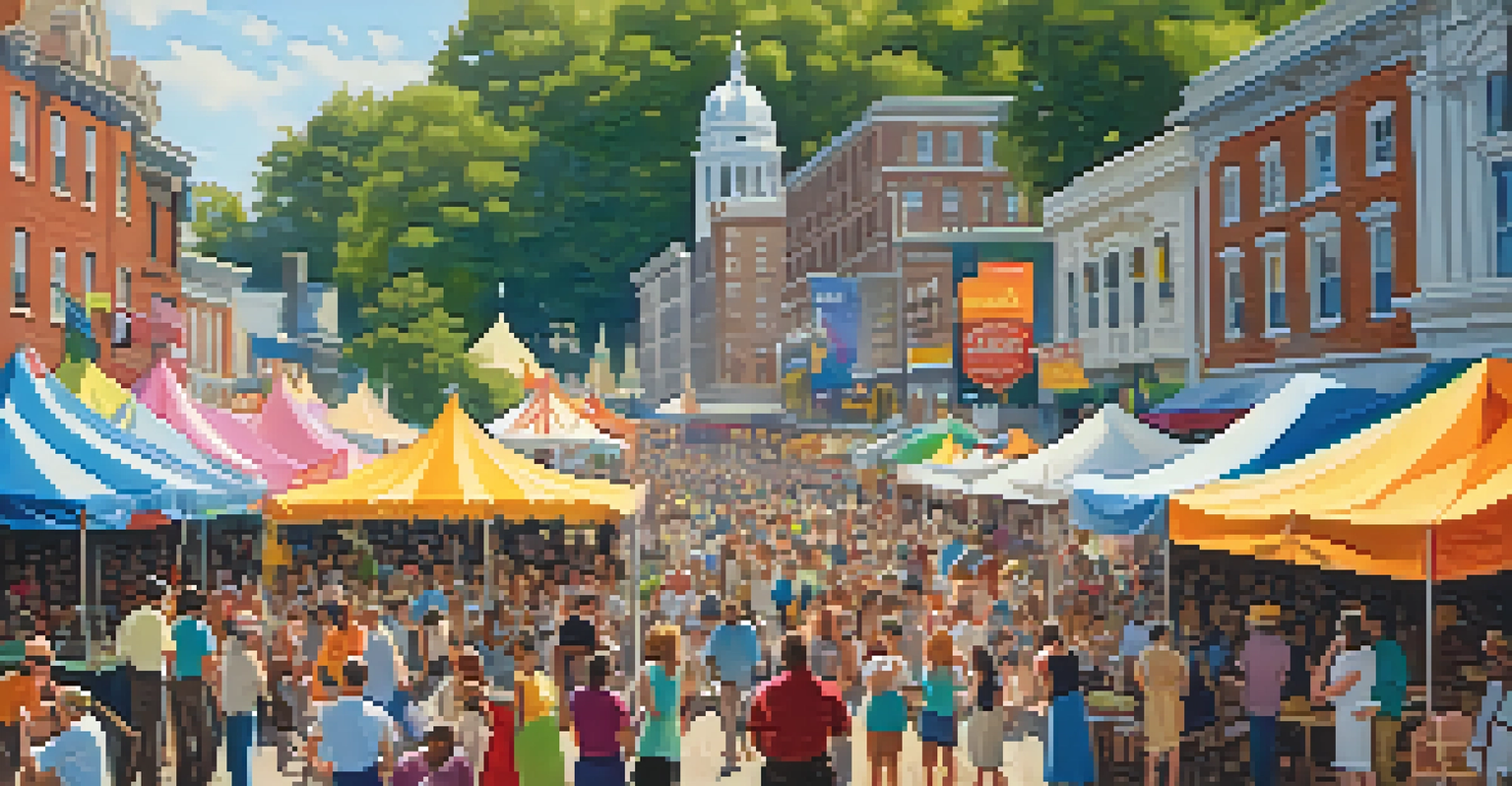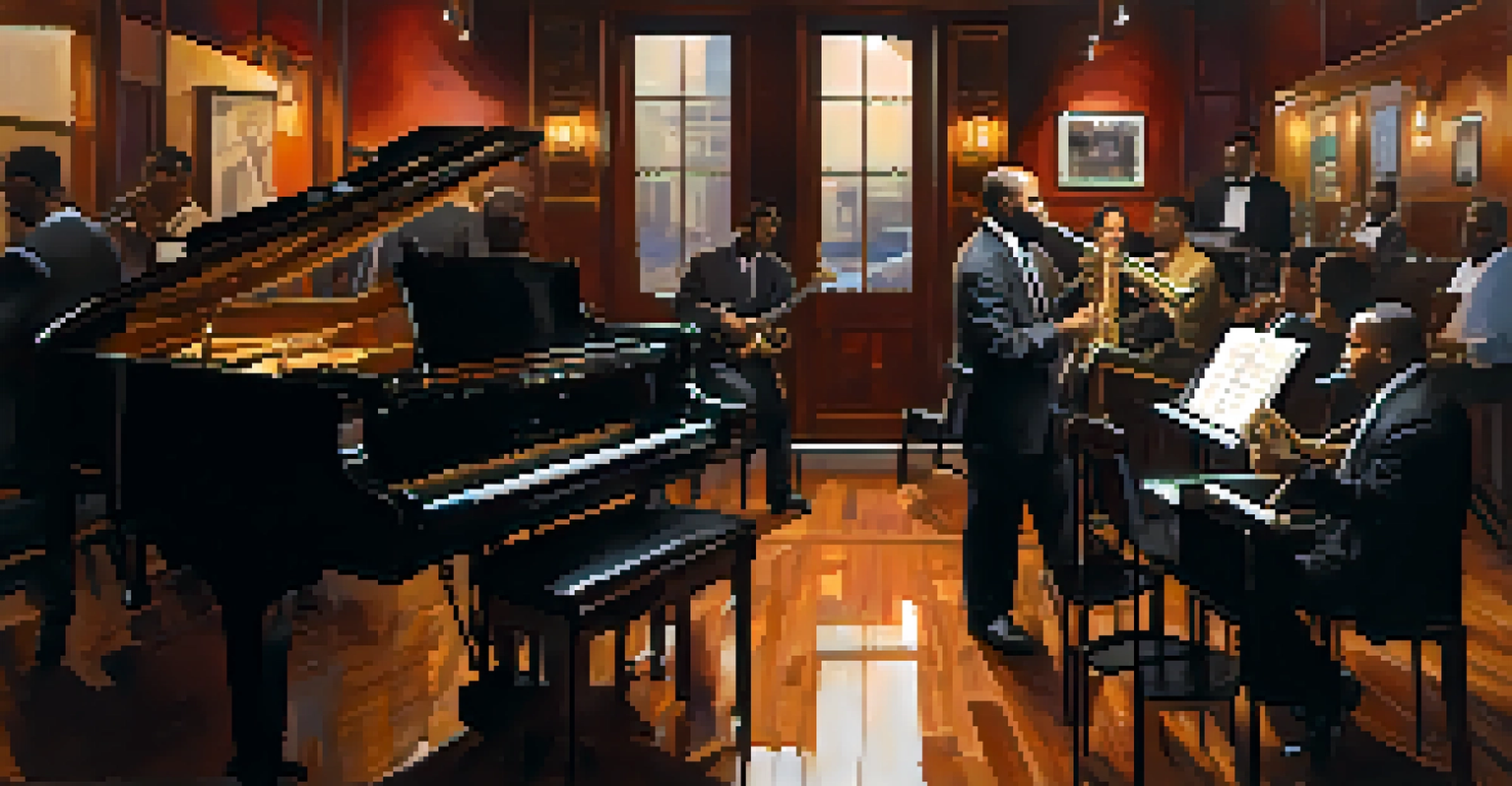The Evolution of Jazz in Pennsylvania: A Cultural Journey

The Roots of Jazz: Early Influences in Pennsylvania
Jazz has deep roots that intertwine with various musical traditions, including blues and ragtime, which found their way to Pennsylvania in the early 20th century. Cities like Philadelphia played a pivotal role as melting pots, where African American musicians could experiment and innovate. These influences birthed a unique sound that would later define jazz as we know it.
Jazz is the only music in which the same note can be played night after night but differently each time.
The early jazz scene in Pennsylvania was marked by iconic venues and local talent, such as the famous Clef Club in Philadelphia. This club became a haven for African American musicians and helped solidify the city as a jazz hub. Musicians would gather here to collaborate, share ideas, and develop their craft, contributing significantly to the jazz movement.
As jazz began to flourish, it also reflected the cultural exchanges happening within Pennsylvania's diverse communities. The blend of different musical styles showcased the rich tapestry of the state’s cultural heritage, setting the stage for what would come next in the evolution of jazz.
The Birth of Big Band Jazz in Philadelphia
The 1920s and 1930s saw the rise of big band jazz, and Philadelphia became a key player in this musical revolution. Local bands, led by talented musicians, began to gain popularity, bringing a new sound to the jazz scene. The smooth, orchestrated style of big band jazz attracted larger audiences and transformed the way people experienced music.

One of the most influential figures during this era was the legendary bandleader Jimmy Lunceford, who drew talent from Pennsylvania. His band was known for its impeccable arrangements and vibrant performances, captivating audiences across the nation. The energy of big band jazz brought people together, creating a sense of community around this evolving art form.
Jazz's Roots in Pennsylvania
Pennsylvania played a crucial role in the evolution of jazz, serving as a melting pot for diverse musical influences and fostering local talent.
As big band jazz flourished, it also paved the way for the next wave of jazz innovation. The combination of improvisation and structured arrangements allowed musicians to express themselves in new ways, while also engaging the audience in a dynamic musical experience.
The Bebop Revolution: A New Jazz Era
The 1940s ushered in the bebop era, which revolutionized jazz with its complex harmonies and fast tempos. This new style was a departure from the big band sound, focusing on smaller groups and individual improvisation. Pennsylvania played a significant role in this transformation, nurturing talented artists like Dizzy Gillespie and Charlie Parker.
To me, jazz is a very serious and very joyful music. It's the one music that can express everything from joy to sadness, from anger to serenity.
In Philadelphia, the emergence of jazz clubs provided a platform for bebop musicians to showcase their talents. Venues like the Blue Note became hotspots for experimentation and collaboration, allowing artists to push the boundaries of jazz further than ever before. This era marked a shift toward a more intellectual appreciation of jazz, inviting listeners to engage with the music on a deeper level.
The bebop movement in Pennsylvania not only changed the sound of jazz but also its cultural significance. It reflected the aspirations of a generation seeking to redefine their identity through art, making jazz a powerful form of expression that resonated with many.
Jazz Fusion: Blending Genres and Styles
The 1960s and 1970s introduced jazz fusion, a genre that combined jazz with rock, funk, and other styles. Pennsylvania's jazz musicians were at the forefront of this trend, experimenting with new sounds and rhythms. This innovative approach attracted a diverse audience and broadened the appeal of jazz beyond traditional fans.
Artists like Grover Washington Jr. from Pennsylvania exemplified this fusion, incorporating elements of R&B and funk into his music. His smooth, soulful sound helped bridge the gap between jazz and popular music, showcasing the versatility of the genre. Jazz fusion became a powerful expression of creativity, allowing musicians to explore new musical territories.
Big Band Jazz Revolution
The rise of big band jazz in Philadelphia during the 1920s and 1930s transformed the music scene, attracting larger audiences and creating a sense of community.
The fusion movement not only diversified jazz but also highlighted the interconnectedness of musical genres. This blending of styles reflected the cultural changes happening across America during this time, making jazz a vital part of the evolving musical landscape.
The Philadelphia Jazz Scene Today
Today, Pennsylvania continues to be a thriving hub for jazz, with Philadelphia leading the charge. The city boasts a vibrant jazz scene, featuring numerous festivals, clubs, and educational programs dedicated to preserving this rich musical heritage. Young musicians are inspired by the legends who came before them, ensuring that the spirit of jazz lives on.
Venues like the Kimmel Center and the Philadelphia Jazz Project attract both local and international talent, creating a platform for new voices in jazz. These spaces foster collaboration and innovation, allowing artists to experiment and connect with audiences in meaningful ways. The ongoing support for jazz in Pennsylvania reflects the community's commitment to nurturing artistic expression.
Moreover, jazz education programs in Pennsylvania play a crucial role in shaping the next generation of musicians. Schools and community organizations offer workshops and mentorship opportunities, ensuring that the legacy of jazz continues to thrive and evolve.
Notable Jazz Festivals in Pennsylvania
Pennsylvania hosts a variety of jazz festivals that celebrate the genre's rich history and contemporary developments. Events like the Philadelphia Jazz Festival and the Bethlehem Musikfest showcase local and national talent, creating a festive atmosphere for jazz lovers. These festivals provide a platform for musicians to connect with audiences and share their passion for this art form.
The festivals also serve as a gathering place for jazz enthusiasts, fostering a sense of community among fans and artists alike. From performances to workshops, attendees can immerse themselves in the world of jazz, learning from seasoned professionals and discovering new talent. This communal spirit is essential to the continued growth of the jazz genre in Pennsylvania.
Modern Jazz Scene Thrives
Today, Pennsylvania continues to nurture jazz through vibrant festivals, educational programs, and venues that celebrate both its rich history and contemporary developments.
Beyond just entertainment, these festivals contribute to the cultural fabric of the state. They highlight Pennsylvania's significance in the jazz world, reminding us of the state's historical contributions while paving the way for future generations of musicians.
Preserving Jazz Heritage: Museums and Archives
Preservation of jazz heritage is vital to understanding and appreciating the genre's evolution. Pennsylvania is home to several museums and archives that document the rich history of jazz, including the Philadelphia Jazz Archive. These institutions play a key role in safeguarding the stories, recordings, and memorabilia of jazz legends.
By showcasing the contributions of Pennsylvania musicians, these museums highlight the state's impact on the jazz landscape. They provide educational resources and programming that engage visitors of all ages, ensuring that the legacy of jazz is passed down through generations. This commitment to preservation reflects a deep respect for the art form and its cultural significance.

Furthermore, the work of these institutions underscores the importance of jazz as a living tradition. By connecting the past with the present, they inspire both musicians and audiences to appreciate the ongoing journey of jazz, making it a continually evolving art form.